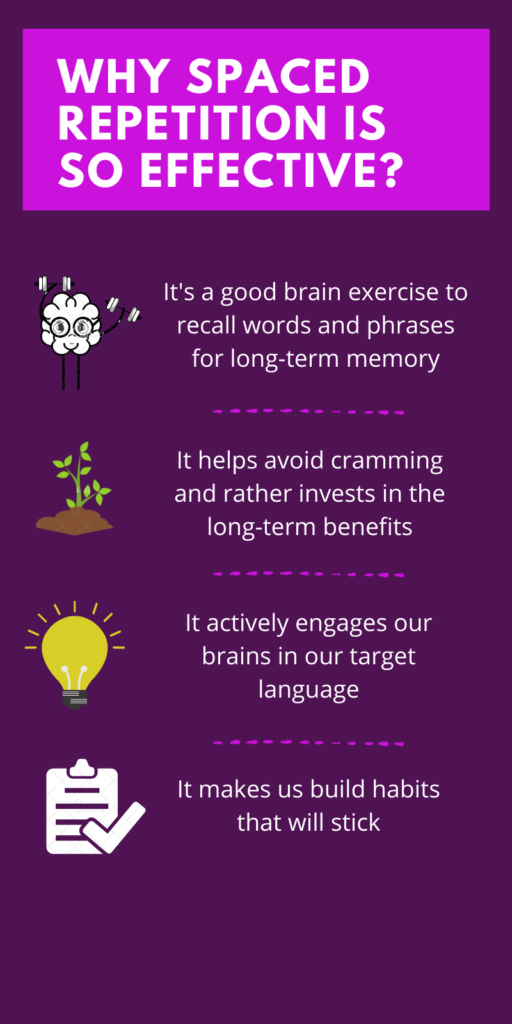What is Spaced Repetition?
Spaced repetition is simply a memory and learning technique that uses repetition to reinforce a concept in our brains over a period of time. Most often we use flashcards for this technique, especially when studying a language.
Let’s say you have 10 flashcards for studying Hebrew and have Hebrew on the front, and English on the back. You go through the flashcards and out of the 10 words, you recalled 6. After, say 15 minutes, you come back and try to remember the 4 words you couldn’t recall. Let’s say of those 4 words you couldn’t recall, now you only forgot 1. So 30 minutes later you try and guess that one word, and bingo now you’ve remembered all 10 words (somewhat). Then at the end of the day you try to recall all 10 words, but are still not able to remember 2/10 words.
So the next morning you wake up, and just focus on those 2 words. The remaining 8 words you can wait until the following morning to review, since you can recall them much better than those 2 words.
Basically, through consistent repetition you are gluing vocabulary words (we’re talking about language learning here) into your long-term memory by forcing your brain to recall those words over a period of time.
Using the Leitner System to Maximize Your Language Learning
Okay so before we move on let’s quickly cover the leitner system. This system is like adding salt and pepper to your steak. It’s not required, but definitely helps.
So let’s say you setup 3 boxes. One is labeled “Ever day” the second “Every other day” and third “Every week” So we go back and review the flashcards and for some reason we find that we still have trouble recalling those same 4 words from the first day. Not a problem! We put 6 of those flashcards into “Every week” since we’re comfortable with them. Of the 4 words, we recall that there are 2 cards we’re consistently having the most trouble with, so we can place them in the “Every day” box, and the other 2 cards we’re just getting tripped up on so we place it in “Every other day”
All we’re doing with the Leitner system is adding consistent intervals based on our needs. Some of us might need to repeat every 30 minutes, while others might need only to repeat in weeks, months, and maybe years. The point is you’re creating figurative, or physical, boxes with specific times to review the material.
Why is it SO Effective When Studying a Language?
Spaced repetition is super effective for language study because you’re exercising your brain to recall words and or phrases to build habit into your long-term memory.

You see, cramming and re-reading notes hardly does any good. Yes, maybe for our short-term memory it can help (I’m not a neuroscientist or psychologist so I could be entirely wrong here), but studies have shown that spaced repetition works because we’re not cramming, but rather investing in the long-term benefits as well as actively engaging our brains in our target language.
We’re building habits that will stick. This is what makes it so useful when studying a foreign language and why you should definitely utilize this technique in your language studies.
How Can I Utilize Spaced Repetition in My Language Study?
You can use spaced repetition by using either physical flashcards or using flashcard apps like Anki. Another language learning resource that does this quite well is Pimsleur. Pimsleur is an audio-based learning software (they used to be CDs back in the day!) that heavily utilizes spaced repetition.
If you’re looking to use the good old flashcard method here’s what you can do (This is geared towards more serious language learners so feel free to adjust according to your needs):
- Everyday, write down 15 new words in your target language
- Write them on a flashcard, or notebook if you don’t have any flashcards
- Go down the list saying each word/phrase and the meaning aloud, and go back up and do it again
- Look at your flashcards and try to recall each word.
- For every word, you can recall place it in box 3 (easy)
- For every word you have a little trouble recalling or you barely got, place it in box 2 (somewhat difficult)
- For every word you have no recollection of, place it in box 1 (difficult)
- *optional* For every word you literally have not even the slightest clue, you can set it in box 1 and adjust the boxes accordingly (very difficult).
- Determine the frequency in which you’d like to review the cards. Box 1 should be reviewed the farthest in time, while the last box should be reviewed most frequently.
- As you become more comfortable with your words, place them closer towards box 3, in which you will review the subject less frequently.
I recommend Box 1 be every day, box 2 every other day, and box 3 be every other week.
Language Learning Resources
Be sure to check out our language learning resources if you’re looking for other material to help you study. We have topics such as the best books to learn Yiddish and the best books to learn Hebrew.

